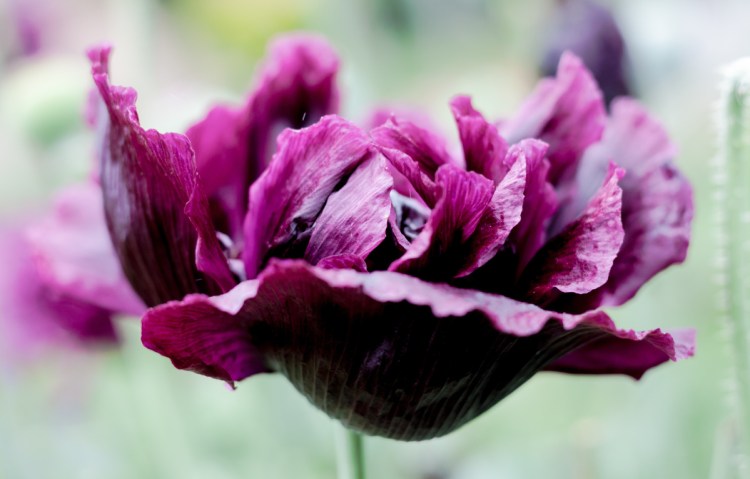As this garden year began, we chose beauty over bounty. We wanted to look at pretty things as a counterpoint to an often-ugly political year – which, fingers crossed, may get better after Tuesday’s vote.
For the most part, our choice worked. The garden has been a distraction for most of the past six months, although part of the distraction has been figuring out what went wrong.
The annuals we added to the vegetable garden didn’t all succeed, some didn’t even sprout, but enough of them blossomed to keep us happy. The flowering shrubs and perennials all did well. Many of the vegetables did not do as well as in the past, which I blame on my crowding things. That was definitely the case with our garlic, which I wrote about in August when we discovered that all of the bulbs were smaller than normal.
The unusually hot weather and yet another summer that included a drought didn’t help the vegetables, either. A two-week vacation in August – the first my wife Nancy and I have ever taken during gardening season – cut production but helped our state of mind, which was more important.
The “Black Peony” poppies that we planted in the spring blossomed in late July and were gorgeous. We let them go to seed and are hoping they join the hundreds of other poppy seeds that landed among the vegetables. I never saw any of the “Danish Flag” poppies we planted.
Despite the heat, most of our warm-weather crops had below-average production. While we had quite a few green peppers, unlike past years, none ripened to full-red. I still haven’t figured out the pepper problem.
We had quite a few slicing tomatoes in late July and August, but the plants stopped producing while we took our vacation. Maybe it was dry enough while we were gone that they never recovered. The “Sun Gold” tomatoes continued producing until the October frost, however.
Summer squash and zucchini had slow but steady production, but – of course – we had to pick about a dozen zucchini that had grown too large for our tastes while we weren’t home. The butternut squash were productive, and we have a lot stored for future winter meals.
I mentioned in July how well the early flowering shrubs – azaleas, rhododendrons and mountain laurels – did this year. This trajectory continued with the later bloomers, as well. All of our viburnums had strong blooms with many of them later producing berries.

Even “Endless Summer” hydrangeas – potentially unreliable in this climate – did extremely well this year.
The hydrangeas also were gorgeous. Even the “Endless Summer” hydrangeas, which I advise Mainers to avoid because they are unreliable in this climate, were covered in deeply colored blossoms late in the year. They must have liked the heat, humidity and late-season rains.
Our blueberry bushes produced a lot of berries. Unfortunately, Nancy and I didn’t get to eat many of them. We suspect the squirrels and chipmunks, which we saw everywhere, feasted on them – although it might have been birds. News stories attributed the large number of dead squirrels on the road this year to a high squirrel population, caused by a bounty of nuts last year, and a shortage of such food this year. A lot of the squirrels and their smaller, cuter cousins, the chipmunks, made up for the lack of nuts by dining on our strawberries and blueberries, and some tomatoes, too.
Over the winter I plan to develop a plan to cover the blueberry bushes next season. I don’t want to rest fabric on the bushes, and I want the protection to go to the ground, to keep out rodents. But I also want be able to pick easily. This is something else to keep me occupied during the dark and cold months.

Squirrels and chipmunks are suspects in the disappearance of some of the berry bounty.
We had a great year for carrots, eating them whenever we wanted, and will soon harvest the remainder for winter keeping. I used the cold frame to plant four different batches, more to keep pests from eating the tiny sprouts than for added heat. We planted two different types of rainbow carrots, and found that the white ones did best, followed by the traditional orange. The blue and red ones produced very few carrots, and those few were small. Next year, I will probably stick to the orange.
While most of our perennial flowers did well this year, it was an especially great year for asters – in our yard as well as other people’s.
This is true for the cultivars we have had in our garden beds for decades as well as for the asters that simply sprouted in the wooded area that I stopped mowing this year.
They have brightened up our days well past the first frost, and I know the bees have enjoyed the late season bounty.
ABOUT THE WRITER
TOM ATWELL is a freelance writer gardening in Cape Elizabeth. He can be contacted at: tomatwell@me.com
Send questions/comments to the editors.


